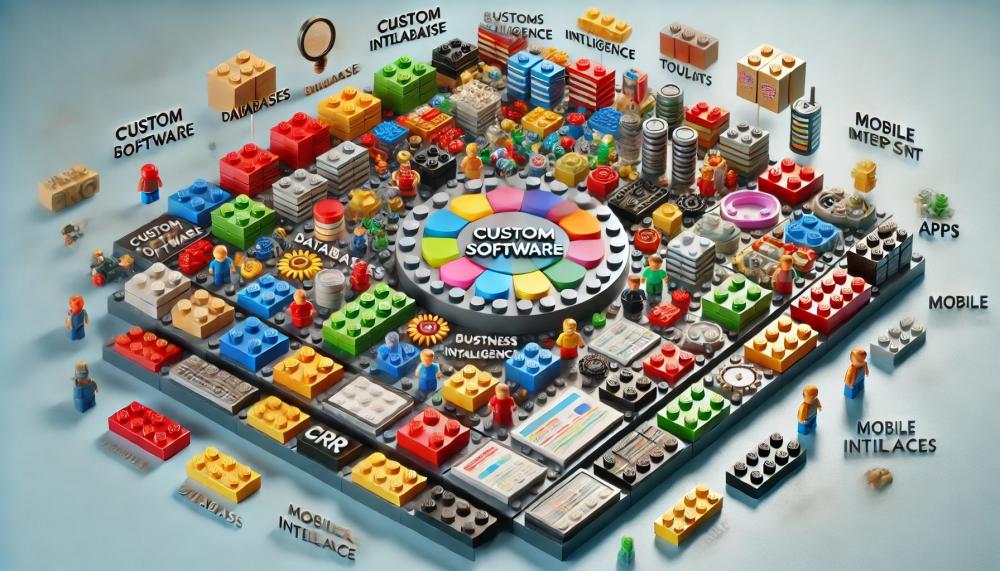Building Custom Software Like Lego: A Creative Approach

When it comes to custom software development, the process can often seem daunting and complex. However, one way to simplify and demystify this process is by comparing it to something more familiar and tangible: Lego. Just like Lego bricks, custom software components can be assembled and reassembled to create unique and scalable solutions tailored to specific needs. This analogy not only makes the concept more accessible but also highlights the versatility and potential of custom software development.
The Foundation: Database Schema Design
At the heart of any custom software lies its database schema, the foundation upon which everything else is built. Just like the base plates in a Lego set, a well-designed database schema provides the stability and structure necessary for the entire system. It is meticulously planned to ensure scalability and flexibility, allowing for future growth and modifications. Each table and relationship within the database is like a Lego brick, fitting perfectly with others to create a robust and efficient data management system.
Building Blocks: Software Components
Custom software development involves various components that come together to form a cohesive system. These components can be compared to different types of Lego bricks, each serving a specific purpose and function.
1. Databases: The core storage systems that hold all the data. Like Lego bricks of various shapes and sizes, databases can be customized to fit the specific needs of a project, ensuring data is stored securely and efficiently.
2. Business Intelligence (BI): This component transforms raw data into meaningful insights, much like how specialized Lego pieces can add unique features to a structure. BI tools analyze data, providing valuable insights that guide business decisions and strategies.
3. Mobile Apps: In today’s digital age, mobile applications are essential. These are like the interactive Lego components, adding functionality and user engagement to the software. Mobile apps allow users to interact with the system on the go, providing flexibility and accessibility.
4. User Interfaces: The visual and interactive elements of the software, akin to the colorful and engaging parts of a Lego set. A well-designed user interface ensures that users can easily navigate and use the software, enhancing their overall experience.
Functional Building Blocks: ERP Features
Just as Lego sets can be enhanced with specialized pieces, custom software can be enriched with various functional modules to meet specific business needs. These functional building blocks are like the specialized components that make a Lego structure more dynamic and capable.
1. Customer Relationship Management (CRM): This module manages interactions with current and potential customers. It’s like adding a communication center to your Lego city, ensuring all relationships are tracked and optimized.
2. Invoicing: Automating the billing process, this feature is akin to setting up a financial system within your Lego structure, ensuring all transactions are handled smoothly and efficiently.
3. Inventory Management: Keeping track of stock levels and inventory movements is like integrating a logistics system in your Lego creation, ensuring everything is in its right place and readily available.
4. Human Resources (HR): Managing employee data and processes can be compared to adding administrative offices in your Lego setup, streamlining all personnel-related activities.
5. Supply Chain Management: Overseeing the flow of goods and services, this module ensures that every part of your Lego city is well-supplied and connected.
6. Project Management: Organizing tasks and timelines, this feature is like incorporating a construction planning office, making sure that all parts of your Lego structure are built on time and within scope.
Customization and Scalability: Adapting to Needs
One of the greatest strengths of Lego is its ability to be endlessly customized and expanded. Similarly, custom software development thrives on flexibility and scalability. As businesses grow and evolve, their software needs to adapt. Whether it’s adding new features, expanding the database, or integrating with other systems, custom software can be modified just like a Lego structure, adding new bricks and pieces to enhance its functionality.
Creativity and Innovation: Endless Possibilities
Lego encourages creativity and innovation, allowing builders to create anything they can imagine. Custom software development operates on the same principle. Developers can design and build unique solutions tailored to the specific needs and goals of a business. This creativity ensures that the software is not only functional but also innovative, providing a competitive edge in the market.
Collaboration and Teamwork: Building Together
Building a complex Lego structure often involves collaboration and teamwork, with multiple builders contributing their skills and ideas. Custom software development is a collaborative effort as well, requiring input from developers, designers, and stakeholders. Effective communication and teamwork ensure that the final product meets all requirements and expectations, delivering a solution that truly fits the business needs.
Conclusion: The Perfect Fit
Just as Lego bricks can be assembled to create anything from simple structures to complex masterpieces, custom software development allows for the creation of tailored solutions that meet specific business requirements. By leveraging the flexibility, scalability, and creativity inherent in both Lego and software development, businesses can build powerful systems that drive growth and success.
At Topcone, we understand the importance of a strong foundation and the potential for innovation. Our approach to custom software development is like building with Lego: methodical, creative, and endlessly adaptable. Let’s work together to build the perfect software solution for your business, piece by piece.